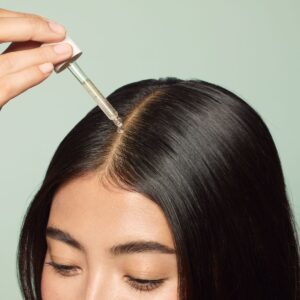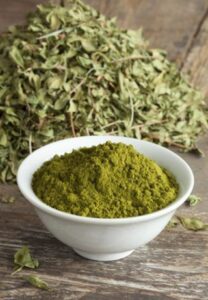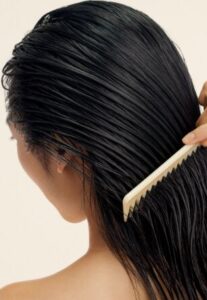How to Keep Your Hair Strong and Breakage-Free This Monsoon
Why Monsoon Affects Your Hair Strength
1) Humidity and Excess Moisture
- Why it matters: The keratin structure of hair is hygroscopic, meaning that it absorbs and releases water in response to variations in humidity. Ambient moisture levels are high for extended periods of time during the monsoon.
- Monsoon Hair Care Water causes the cuticle and cortex to swell, diffuses into the hair shaft, and destroys the short-term hydrogen bonds in keratin. Hygral fatigue, a continuous cycle of swelling and shrinking, erodes the protective cuticle tiles, roughens the surface, and increases the likelihood of breakage and split ends in strands.

- What’s happening inside the strand:
- Humidity increases porosity and friction between strands by lifting the cuticle scales.
- Cortex softening: The cortex becomes plasticized by too much water, which lowers its tensile strength. You’ll find that wet hair snaps more readily and stretches more.
- Protein–moisture imbalance: Hair that is overly wet and lacks sufficient structural support from proteins and lipids becomes brittle, frizzy, and limp.
- Effects on the scalp: Sweat and moisture dilute sebum and combine with dust to block pores. In addition to changing the microenvironment of the scalp (more on infections in the next section), prolonged wetness also indirectly stresses the anchoring of hair.
- Signs include: a poofy shape, a lack of curl pattern definition, limp roots, more shedding while detangling, more split ends, especially on previously color-treated or heat-damaged hair, and frizz that reappears after styling.
- Care strategies grounded in hair science:
- Pre-wash oiling (15–30 minutes): Applying a thin layer of sunflower, coconut, or argan oil minimizes cuticle swelling and water absorption. Coconut oil’s lauric acid’s affinity for hair proteins makes it particularly helpful for lowering hygral fatigue.
- pH-balanced cleansing: To reduce cuticle lift, use a mild, sulfate-free shampoo with a pH of 4.5 to 5.5. Pay attention to the scalp; let the suds wash the lengths.
- Condition for slip + barrier: To smooth the cuticle and lessen friction, use conditioners that contain cationic surfactants (like behentrimonium) and film formers (like polyquaterniums, hydrolyzed proteins).
- Smart leave-ins: Lightweight film formers (such as peptides or plant polymers) combined with anti-humidity lotions or serums aid in locking style.
- Humectant balance: To avoid moisture overload in extremely humid weather, use occlusives (oils, butters) or barrier polymers in conjunction with strong humectants (such as high-dose glycerin).
- Drying technique: Blot with a cotton T-shirt or a microfiber towel; do not rub. Diffuse on low or let air dry. Don’t tie your hair damp.
- Protective styles: Loose buns and braids minimize tangling and the surface area exposed to moisture.
- Trim + repair: Integrity can be preserved with routine end dusting and sporadic bond-building treatments.
2) Rainwater Impurities and Scalp Infections
- Why it matters: Not all rainwater is “pure.” The first showers in urban and industrial regions convey metal traces, particle debris, and dissolved gasses (SO₂/NOₓ). Rainwater can absorb contaminants and germs when it flows off trees and roofs. This water can damage the skin barrier and microbiota when it sits on the scalp, raising the risk of folliculitis, seborrheic dermatitis, and dandruff. Anxiety around follicles can impair anchoring, and a worried scalp frequently sheds more hair.

- How the scalp-hair system is stressed by impurities:
- pH disruption: Polluted rain can be more acidic than natural rain, which is already mildly acidic. Regular exposure can aggravate sensitive scalps, causing flare-ups of redness and irritation.
- Monsoon Hair Care Residue + buildup: Metals, dust, and soot stick to the hair cuticle, giving it a rougher, more tangly feel. They can also cause oxidative damage, particularly to colored hair.
- Microbial overgrowth: Malassezia and other yeast thrive on a wet, clogged scalp. Flakes, irritation, and inflammation brought on by overgrowth might cause hairs to enter the shedding (telogen) phase too soon.
- Secondary infections: Bacteria enter through tiny cracks caused by scratching, resulting in pustules or sore spots (folliculitis).
- Protective protocol after getting caught in rain:
- Rinse right away: To get rid of particles and bacteria, rinse your hair and scalp as soon as you can with clean water.
- Use a moderate, pH-balanced shampoo for a gentle wash. One to three times a week, switch to an antifungal/antimicrobial shampoo if you have dandruff or itching (search for piroctone olamine, climbazole, zinc pyrithione, or ketoconazole). If symptoms continue, natural adjuncts like tea tree oil can be helpful, but they shouldn’t be used in place of proven active ingredients.
- Conditioning that is barrier-friendly: Avoid putting conditioner on the scalp; concentrate on lengths to remove debris from the cuticle without obstructing the scalp.
- Complete drying: Make sure the scalp roots are completely dry by patting them dry. Tight hairstyles increase the risk of infection and retain moisture, so avoid them on damp hair.
- Comb hygiene: Every week, clean brushes and combs. Avoid sharing them when it’s raining.
- Extras for scalp care: To lift scales and lessen follicular debris, consider exfoliating your scalp on a regular basis with a mild BHA (like salicylic acid); stay away if your scalp is injured or sensitive.
- Lifestyle assistance: Sleep and stress management have an impact on scalp immunity. Deficits can exacerbate shedding, so make sure your diet contains enough protein, iron, zinc, vitamin D, and B-complex.
Step 1: Choose the Right Shampoo & Conditioner
- Why Sulfate-Free Shampoos Work Best in Monsoon:
- Why it matters: The monsoon season poses several problems for your hair, including high humidity, frequent wetness, contaminated rainwater, and infections of the scalp. Even though it might not seem like much, the shampoo you use affects how effectively your cuticle integrity and scalp barrier are maintained throughout this time. Sulfate-free shampoos deserve a place here.

- Why sulfate-free matters in humid months:
- Softer cleansing: Shampoos without sulfates employ softer surfactants, such as sodium cocoyl isethionate, decyl glucoside, and cocamidopropyl betaine. Without harshly removing the cuticle or rupturing the scalp barrier, they cleanse.
- Balance of moisture: Your hair already absorbs too much water when the humidity is high. By making cuticles even more swollen, harsh sulfates exacerbate hygral exhaustion. Sulfate-free products keep cuticles smoother, which lessens breakage and frizz.
- Health of the scalp: Dandruff and fungal infections are more likely to occur on damp scalps. Sulfate overcleaning can result in rebound oiliness and irritation, which makes the environment ideal for the growth of microorganisms. A gentle shampoo maintains the pH balance of the scalp between 4.5 and 5.5, which inhibits the growth of yeast (Malassezia) that causes dandruff.
- Color and treatment safety: If your hair is colored, keratin-treated, or chemically smoothed, sulfate-free formulas are essential in monsoon. They prevent premature fading and save pricey treatments.
- Consistency: Because of perspiration, rainwater, or pollution, you’ll probably wash your hair more regularly throughout the rainy season. Sulfate-free shampoos provide regular, safe washing without making hair brittle and dry.
- What to look for:
- Labels like “sulfate-free,” “gentle cleansing,” or “low-foam formula.”
- Key ingredients: aloe vera, tea tree (for scalp freshness), rosemary or peppermint (for circulation), mild humectants like panthenol, and hydrolyzed proteins.
- Avoid overly heavy oil-based shampoos in monsoon—they may feel greasy due to humidity.
- Conditioner Tips for Frizz Control Without Weighing Hair Down
- Why it matters: Hair experiences two extremes during the monsoon season: it feels oily and limp if over-conditioned, and frizzy and poofy on humid days. It’s crucial to pick the correct kind, quantity, and application of conditioner to control frizz without causing volume loss or greasy scalps.
- The science behind controlling frizz:
- When raised cuticles permit unequal water absorption and cause misaligned fibers, hair frizz develops. Conditioners assist by:
- using cationic compounds that neutralize static and smooth cuticles, such as behentrimonium chloride and cetrimonium chloride.
- using lipids and emollients (such as silicones, butters, natural oils, or their plant-based substitutes) to produce a thin coating that reduces tangling and friction.
- supplying humectants in moderation (such as aloe or panthenol) to draw in precisely the right amount of moisture without going too.
- Conditioner mistakes in monsoon:
- Applying directly to scalp → clogs pores, increases greasiness, and raises dandruff risk.
- Using heavy butters (shea, cocoa) in high amounts → weigh hair down in humidity.
- Over-rinsing → washes away active ingredients before they can bind.
- Smart conditioner strategies:
- Focus on mid-lengths to ends: Apply conditioner from the ear level downwards. This prevents porous ends while reducing scalp heaviness.
- Choose lightweight formulas: Look for conditioners labeled “anti-frizz,” “moisture balance,” or “volumizing.” Ideal ingredients include:
- Fatty alcohols (cetyl, stearyl): give slide without greasiness.
- Light oils & esters (argan, jojoba, hemisqualane): resemble sebum and seal cuticles.
- Proteins & peptides (hydrolyzed keratin, wheat, rice): repair cuticle gaps and minimize edema.
- Film formers (polyquaterniums, hydroxypropyltrimonium honey): humidity shields.
- Timing matters: 2–3 minutes is plenty for absorption. For extra frizz control, consider “reverse washing” (conditioner first, shampoo second) if your hair gets easily weighed down.
- Leave-ins are your friend: Instead of overloading rinse-off conditioner, conclude with a lightweight leave-in cream/serum on damp hair. This gives long-lasting anti-frizz protection without weight.
- Weekly mask upgrade: Once a week, replace your conditioner with a mask rich in proteins or bond builders. This strengthens hair inside, making it less vulnerable to frizz.
- Silicone or silicone-free? Small, water-dispersible silicones like amodimethicone work well in monsoon to fight frizz. If you avoid silicones, alternatives like aloe-based gels or hydrolyzed proteins can smooth well.
Step 2: Keep Your Scalp Clean & Dry
- The Value of Shampooing Your Hair After Getting Wet in the Rain (about 500 words)
- Why it matters: Although rainwater may appear clean and natural, it really contains contaminants, microorganisms, and toxins that can harm the health of the scalp and hair. Rainwater during the monsoon season, particularly in cities, combines with smoke, dust, and industrial pollutants before it reaches you. This water weakens hair shafts, changes the microbiota on your scalp, and interferes with the natural barrier. Itching, dandruff, scalp infections, and hair loss result if it is not removed.

- The science of rainwater on hair:
- Rain is inherently somewhat acidic, but in urban areas, it may contain sulfur dioxide and nitrogen oxides, which can make it enough acidic to irritate the scalp. Long-term exposure might cause cuticle lifting and dryness.
- Microbial contamination: Bacteria, fungus, and spores are frequently present in rain that falls on surfaces or forms puddles. Dandruff and seborrheic dermatitis are associated with Malassezia yeast, which thrives on a damp scalp.
- Residue accumulation: Dust, metals, and pollutants adhere to hair fibers, causing them to become rough, lifeless, and more difficult to untangle. Additionally, this buildup hastens the cuticle’s oxidative stress.
- Why immediate washing helps:
- Eliminates impurities: Before pollutants become embedded in follicles, they are flushed out with a fast rinse or shampoo.
- restores pH balance: Using a gentle, pH-balanced shampoo to wash your hair helps shield it from the irritation that acid rain might bring.
- Stops the growth of fungi: Maintaining a dry and clean scalp lowers the chance of infection, flaking, and irritation.
- Preserves cuticle integrity: Mild cleaning eliminates buildup and makes the cuticle flat again, which lessens tangling and frizz.
- How to wash correctly after getting drenched:
- Don’t wait: Rinse right away. If shampooing isn’t practical, even a simple water rinse will assist.
- Select gentle cleaners: Shampoos that are mild or sulfate-free and contain extracts of tea tree, neem, or rosemary are great for keeping the scalp feeling fresh.
- Double cleansing: Use a two-step wash to remove pollutants and then nourish yourself after you’ve been completely soaked.
- Strategic conditioning: To restore softness without making the scalp feel heavy, only use conditioner on the mid-lengths and ends of hair.
- Dry fully: Make sure the scalp is completely dry before styling by patting it dry with a microfiber towel after washing.
- Avoid Tying Wet Hair to Reduce Breakage
- Why it’s important One of the most common blunders made during the monsoon season is to tie hair when it is still damp.
- Because the cuticles are lifted, the cortex is inflated with water, and the suppleness is reduced, wet hair is at its weakest.
- Tight hairstyles like buns or ponytails that apply strain cause breaking, traction on the roots, and long-term thinning.
- Because hair takes longer to dry and is exposed for longer periods of time in humid conditions, the damage is worse.
- The science behind wet-hair fragility:
- Weakened hydrogen bonds: Temporary hydrogen bonds in keratin contribute to the strength of hair. These connections are disrupted when wet, leaving strands that are supple but brittle.
- Cuticle vulnerability: Hair becomes more porous and vulnerable to frictional damage when water raises the cuticle scales. These elevated cuticles are compressed while tying, which causes chipping and breakage.
- Wet hair weighs more than dry hair, which causes root tension. Over time, traction alopecia, or localized hair loss, can result from tight hairstyles that pull on follicles.
- Microbial risk: A damp, tied-up scalp retains heat and moisture, making it the ideal environment for bacteria and fungi to grow and exacerbate dandruff and itching.
- Healthier alternatives:
- Prior to tying, let your hair air dry 70–80%. To rapidly and frictionlessly blot water, use a microfiber towel.
- Low-tension styles: Go for soft scrunchies or loose braids if you have to knot damp hair. Steer clear of tight elastics and rubber bands that snag wet hair.
- Protective drying: To avoid heat damage, use a blow dryer set on low heat with a diffuser if necessary, keeping at least 6 inches away.
- Silk or satin accessories: To lessen friction when hair is a little wet, use satin pillows, scarves, or scrunchies.
- Root care: For scalp nourishment, massage a mild, non-comedogenic oil (such as grapeseed or jojoba) once or twice a week. More robust follicles are better able to withstand stress.
Step 3: Use Lightweight Oils & Gels
Why Heavy Oils Can Damage During Monsoon
- Why it matters: While oiling is a traditional Indian hair care practice, it becomes even more important during the monsoon season. Heavy oils (such as castor, mustard, or mineral oil) may cause more harm than good during this season, even though hair and scalp do benefit from nourishment. Thick oils are detrimental to the health of the scalp and hair because of the humid, sticky environment, increased pollutants, and microbial growth.
- The problem with heavy oils in monsoon:
- Clogged pores: The scalp is covered in a thick coating of heavy oils. Sweat and pollutants combine with this layer in humid conditions, blocking follicles and causing dandruff, itching, or even folliculitis.
- Washout is challenging because thick oils are difficult to emulsify. Multiple shampooing sessions may be necessary, as this depletes natural moisture and weakens hair fibers. Ironically, excessive cleaning causes strands to become brittle.
- Scalp infections: Dirt and microbes are drawn to an oily, sticky scalp. When coupled with ongoing moisture, this makes the ideal environment for the growth of fungi.
- Breakage of hair: Oily, wet hair gets thicker. Root traction is increased when it is tied or left damp, which causes follicles to feel “weak” and break.
- The scientific perspective: Oils can coat the cuticle (like mineral oil) or penetrate the hair shaft (like coconut oil with lauric acid). Although these advantages are genuine, the monsoon season changes the environment of the scalp by increasing the amount of sebum, wetness, and microbiological burden. Instead of balancing these circumstances, heavy oils make them worse.
- From the standpoint of a dermatologist, thick oils can be tolerated on a dry scalp throughout the winter, but they frequently exacerbate dandruff and itching during the monsoon season. During humid conditions, those with seborrheic dermatitis should especially refrain from receiving strong oil massages.
Best Lightweight Options: Hibiscus Gel, Rosemary Gel, Aloe Vera
- Hibiscus Gel – The Strength Restorer
- Conventional roots: Hibiscus leaves and flowers are essential Ayurvedic ingredients for boosting hair development and minimizing hair loss.
- How it works: Hibiscus gel provides vitamin C, amino acids, and antioxidants (anthocyanins), which support collagen formation at the root level and nourish follicles. Hair shafts are hydrated by its mucilage, which facilitates detangling.
- Benefits during the monsoon season include preventing excessive hair loss, conditioning hair without making it heavy, and revitalizing roots. It works nicely as a gentle leave-in for damp hair or as a scalp massage before washing.
- Rosemary Gel – The Dandruff & Circulation Booster
- Science-backed hero: Rosemary is well known throughout the world for increasing hair thickness and circulation. Research indicates that when it comes to encouraging hair growth over time, rosemary extract and minoxidil are similar.
- How it works: Rosemary gel has antibacterial and anti-inflammatory qualities. It promotes increased follicular activity, reduces itching, and regulates sebum production on the scalp.
- Benefits during the monsoon: Perfect for people with weak roots or dandruff flare-ups. The lightweight gel shape guarantees rapid penetration without sticking, revitalizing the scalp.
- Aloe Vera – The Universal Soother
- Hydration powerhouse: Aloe vera gel is a natural humectant since it contains enzymes, polysaccharides, and vitamins A, C, and E.
- How it works: It improves the protective barrier, lessens scalp irritation, and retains moisture. By gently exfoliating dead skin cells, its natural enzymes avoid clogging follicles.
- Benefits during the monsoon: Ideal for reducing frizz, relieving irritated scalps, and maintaining bouncy, light hair. It can be added to DIY masks for an additional moisturizing boost, used as a scalp soother, or combined with pre-wash gel.
Step 4: Strengthen Hair with Weekly Masks
DIY Natural Masks for Monsoon
- In the monsoon, why weekly masks are important
- The continual humidity, pollutants from rain, and frequent washing that monsoon brings to hair weakens the cuticle, dries out the cortex, and throws off the equilibrium of the scalp. Because heavy oils might block the scalp during this season, regular oiling is insufficient. Lightweight, nutrient-rich hair masks can help with that. A weekly mask helps hair better resist frizz, tangling, and breakage by restoring hydration, adding resilience, and replenishing lost proteins.

- Curd + Methi (Fenugreek) Mask – Anti-Frizz & Scalp Soother
- Ingredients: 2 tablespoons pulverized methi seeds (soaked overnight) and ½ cup fresh curd.
- How it operates:
- Lactic acid, which is found in curd, gently washes the scalp, and probiotics help to restore the balance of microorganisms. Frizz is naturally tamed by its lipids, which cover the cuticle.
- Rich in lecithin, nicotinic acid, and protein, methi seeds fortify hair follicles, lessen shedding, and calm irritated scalps.
- Application: Evenly apply to the scalp and lengths of hair, let sit for half an hour, and then rinse with a gentle wash.
- Ideal for: Oily scalps that are prone to frizz and dandruff.
- Aloe Vera + Honey Mask – Hydration & Shine Booster
- Ingredients: 1 tablespoon raw honey and 3 tablespoons fresh aloe vera gel.
- How it operates:
- Aloe vera soothes an itchy scalp, smoothes rough cuticles, and hydrates with vitamins and polysaccharides.
- As a natural humectant, honey draws moisture while also acting as an antibacterial to prevent the fungal overgrowth that is typical during the rainy season.
- Application: Massage the scalp and run it along the lengths, then rinse after 20 to 25 minutes.
- Ideal for: A dry, frizzy, or itchy scalp that need moisture.
- Banana + Yogurt Mask – Strength & Elasticity Restorer
- Ingredients: 2 tablespoons yogurt, 1 mashed ripe banana, and optional 1 teaspoon honey.
- How it operates:
- Natural oils and silica, which are abundant in bananas, increase elasticity and decrease breaking.
- Probiotics and protein from yogurt help to build and nourish hair.
- A further boost of moisture and smoothness is provided by honey.
- Apply from scalp to ends, blend into a homogeneous paste, let sit for 20 to 30 minutes, and then rinse well.
- Ideal for: Hair that needs strength and softness and is brittle and prone to breaking.
How Protein and Hydration Restore Strength
- Why hair needs protein + hydration balance:
- Keratin protein makes about 95% of hair; the remaining portion is made up of water and lipids. Humidity causes the hair shaft to swell during the monsoon, raising cuticles and causing proteins to drain.
- Natural oils are removed by frequent washing, which makes the shaft brittle. Weak, limp, and frizzy hair results from not replenishing it. Protein (for structure) and moisture (for flexibility), two essential components of robust, resilient hair, are restored with a quality mask.
- Role of protein in restoring strength:
- Fills micro-gaps: Natural proteins from yogurt, methi, and bananas or hydrolyzed proteins (keratin, wheat, silk) stick to damaged cuticles to fill in gaps and lower porosity.
- Enhances elasticity: Hair bends without breaking because protein strengthens the cortex.
- Enhances smoothness and shine: Hair that has stronger cuticles reflects light more effectively, giving it a healthier appearance.
- Minimizes breakage: Stronger connections result in fewer snapped ends or mid-shaft splits.
- Role of hydration in restoring flexibility:
- Retention of moisture: Hydrators that bind water molecules inside the hair shaft include glycerin, honey, and aloe. By doing this, brittleness brought on by protein overload is avoided.
- Cuticle alignment: Hair that is well-hydrated has smoother cuticles, which reduce tangles and frizz.
- Comfort of the scalp: Hydration is particularly important for the scalp since it avoids the frequent monsoon-related dryness, itching, and flaking.
- Examples of natural protein + hydration synergy:
- Strength and smoothness are balanced by the combination of curd (protein), methi (lecithin), and aloe vera (hydration).
- Together, the banana (silica for elasticity), yogurt (protein), and honey (hydration) mend and moisturize.
- Hibiscus (amino acids) + Rosemary (circulation enhancer) + Aloe Vera (hydration) → fortifies roots and retains moisture.
- How to tell what your hair needs more of:
- If hair is frizzy, stretchy, and limp → needs protein.
- If hair is dry, brittle, and snapping → needs hydration.
- If hair is rough and dull overall → needs both in balance.
Step 5: Eat for Strong Hair from Within
- Foods High in Omega-3s, Iron, and Protein
- What you put into your body is just as crucial for the health of your hair as the items you use on the outside.
- Keratin is the main protein that makes up hair, and if you don’t get enough protein from your diet, your hair can easily become thin, brittle, and prone to breaking.
- This is especially true during the monsoon season, when environmental stress already weakens hair.
- Your hair will have the building blocks it needs for growth and repair if you include foods high in protein, such as eggs, paneer, lean meats, lentils, and chickpeas.
- For vegans, quinoa and dals are great ways to maintain healthy keratin levels.

- Iron is a vital component that is frequently disregarded, aside from protein. Your hair follicles receive less oxygen when you are iron deficient, which weakens the roots and causes excessive shedding.
- Iron consumption is further more important because monsoon-related scalp problems can exacerbate this issue. Iron levels can be restored by eating dates, raisins, lentils, and green leafy vegetables including spinach, fenugreek, and moringa leaves.
- Combining foods high in iron with foods high in vitamin C (such as lemon, oranges, or amla) improves absorption and keeps your follicles healthy.
- Omega-3 fatty acids are another crucial nutrient category for healthy hair during the monsoon. Omega-3s are well-known for their moisturizing and anti-inflammatory qualities.
- They also strengthen hair follicles and promote scalp health, which lowers the risk of dandruff and irritation brought on by humidity. Rich sources include foods like walnuts, chia seeds, flaxseeds, and fatty seafood like mackerel or salmon.
- To increase omega-3 intake, vegans might incorporate walnut or flaxseed oil in their diet.
- You may build a nutrient-rich foundation that fortifies hair from the inside out and helps it resist the difficulties of the rainy season by striking a balance between protein, iron, and omega-3 fatty acids.
Hydration Tips for Scalp and Hair Health
- Hair strength is greatly influenced by nutrition, but hydration is just as crucial. Many people believe that there is enough moisture in the air during the monsoon, yet too much humidity frequently results in cellular dehydration.
- This is because when the weather is damp but you unintentionally cut back on your water consumption, your body’s natural hydration balance is upset. The outcome? hair strands that lose their suppleness, a dry scalp, and weak roots.
- Hair development requires consuming a minimum of 2.5 to 3 liters of water every day.
- Water keeps the scalp hydrated, carries nutrients to your hair follicles, and avoids dryness, which can cause irritation and dandruff.
- In addition to increasing hydration, herbal infusions such as hibiscus tea, green tea, or fenugreek water also provide a nutritional boost.

- Drinking water is only one aspect of staying hydrated; another is eating foods high in water. Vitamins that immediately enhance hair strength are delivered by fruits like papaya, oranges, cucumbers, and watermelon, which also naturally hydrate the body. These nutrients aid in the fight against free radical-induced oxidative stress, which can otherwise weaken hair during the monsoon season.
- Last but not least, stay away from sugary drinks and excessive coffee since they dehydrate the body and have an indirect effect on scalp moisture. Make staying hydrated a conscious habit instead by choosing light soups or herbal teas, drinking water throughout the day, and snacking with fresh fruits. Your scalp maintains a balanced sebum production when your body is properly hydrated, which makes your hair less frizzy and easier to manage even when it rains.
Final Thoughts: Monsoon-Proof Your Hair
- While cool weather and pleasant showers are welcome during the monsoon season, hair problems including frizz, breakage, dandruff, and dullness are also common.
- Although many people attempt quick cures, the truth is that consistent, delicate care is necessary to safeguard your hair throughout this season. The good news? Even during the wettest months, you can maintain healthy, strong hair with the correct routines and treatments.

- Consistency is Key for Results
- One-time efforts don’t produce long-lasting results when it comes to hair care.
- Seasonal hair damage cannot be resolved by oiling your scalp sometimes or washing your hair once with a gentle, sulfate-free shampoo.
- Your scalp and hair strands can adjust to a healthy habit through consistency.
- Your weekly routine should include, for example, washing your scalp frequently to get rid of perspiration and debris, using a light conditioner thereafter, and shielding your hair from environmental aggressors.
- Similar to skincare or fitness, hair health improves over time with consistent practice rather than fast fixes.
- You will see noticeable results in a matter of weeks if you follow the instructions, which include nutritional assistance, regular oiling, cutting, protective styles, and wise washing practices.
- Focus on Scalp Health + Gentle Care
- Since the scalp is where hair development starts, a good hair care regimen always starts there.
- The monsoon season frequently causes an oily, flaky, or itchy scalp because of the proliferation of fungi and excessive moisture.
- The roots will stay strong if scalp health is prioritized through frequent cleaning, mild exfoliation (with natural cleansers like neem or tea tree), and light nutrition.
- However, during this season, frequent use of heat tools or aggressive styling might increase breaking.
- Instead, hair integrity is preserved by gentle methods including air drying, using a wide-tooth comb, and avoiding tight hairstyles.
- If you think of your scalp as fertile soil, your “roots” will grow stronger the healthier it is.
- With the Right Routine, Monsoon Doesn’t Have to Mean Hair Breakage
- It’s simple to attribute frizz and hair loss on the rain, but the truth is that your routine dictates the results.
- The way your hair reacts to the season can be changed with the correct mix of preventative practices, hydrating yet lightweight products, balanced diet, and thoughtful styling. You may really enjoy monsoons without fear of damage, rather than hating the dampness.
- Healthy, resilient, and lustrous hair is the ultimate goal, and every little step counts, from routine cutting to oil massages and protective hairstyles.
FAQS
1. Why does my hair break more during the monsoon?
Excess humidity causes hair to swell, become weak, and tangle easily. Combined with scalp infections and product buildup, this leads to higher breakage.
2. How often should I wash my hair in the rainy season?
Wash 2–3 times a week with a mild, sulfate-free shampoo to keep your scalp clean without over-stripping natural oils.
3. Can oiling my hair help during monsoon?
Yes, gentle oiling with lightweight oils (like coconut or argan) nourishes roots, prevents dryness, and strengthens strands. Avoid heavy oils that attract dust and cause buildup.
4. Should I avoid conditioner in humid weather?
No—skipping conditioner makes hair frizzier. Use a lightweight, rinse-off conditioner or leave-in serum on lengths only (not scalp).
5. What hairstyles prevent frizz during monsoon?
Protective hairstyles like braids, buns, or ponytails reduce friction, tangling, and exposure to humidity.
6. Is hair fall normal during monsoon?
Yes, mild seasonal hair fall is common due to increased humidity and fungal infections. If hair fall persists for more than 2 months, consult a dermatologist.
7. Can I use DIY hair masks during monsoon?
Yes—natural masks like aloe vera + hibiscus, or yogurt + neem can soothe scalp, reduce dandruff, and strengthen hair. Always rinse thoroughly to avoid buildup.
8. Does diet really affect hair health in this season?
Absolutely. Eating protein-rich foods, leafy greens, and vitamin C–rich fruits boosts collagen and keratin production, reducing breakage.
9. Should I avoid rainwater completely?
Yes, rainwater often contains pollutants that weaken hair and irritate scalp. If your hair gets wet, rinse immediately with clean water and use a mild shampoo.
10. Can trimming hair really reduce monsoon breakage?
Yes, trimming removes split ends, preventing further breakage. Regular trims every 6–8 weeks keep hair healthy and resilient during monsoon.
